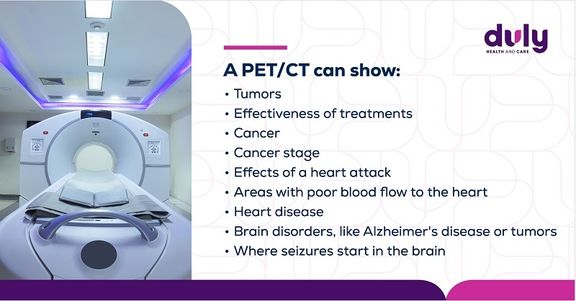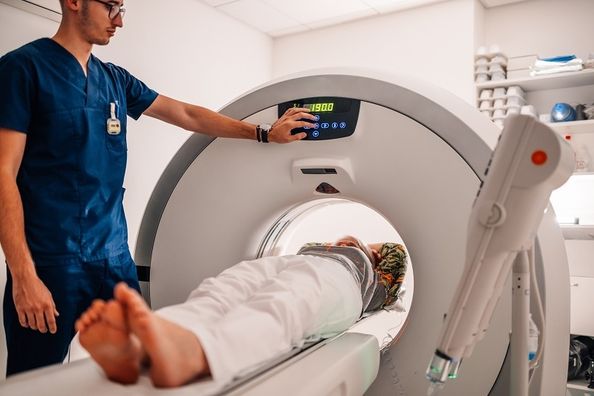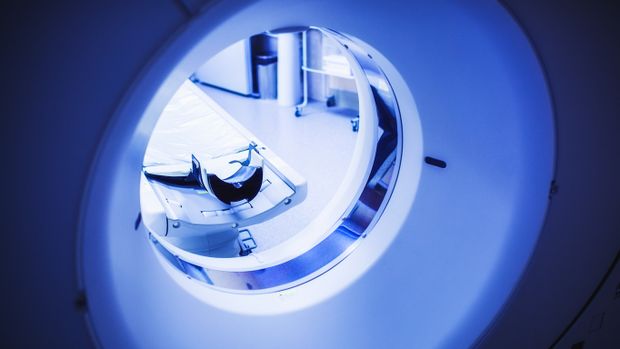Your provider has told you that you need a PET/CT scan. They explain that PET stands for “positron emission tomography,” that CT stands for “computed tomography,” and that these are common types of imaging tests that allow your provider to see what’s happening in your body.
After a quick joke confirming that a PET scan is a scan of your body and not Rufus’s, your mind starts racing with questions. What exactly is a PET/CT scan? What does it show?
Here are answers to common questions about PET/CT scans.
What Are PET Scans and CT Scans?
A PET scan is a form nuclear imaging. It uses a small amount of a radioactive substance called a tracer (also called radiotracers or radiopharmaceuticals), a computer, and a special camera to take images of your organs and tissues. A CT scan uses X‑rays and a computer to create detailed 3D images of your body.
Both tests are painless and are typically outpatient procedures, meaning you can go home the same day.
Is a PET Scan a Type of CT?
You will often see “PET/CT,” but PET and CT scans are actually two different tests.
PET scans look at how your organs function while CT scans examine the structure of your organs.
It’s common for both tests to be taken at the same time. The PET/CT combo puts the images from each test together into a more detailed image. This gives a clear, in-depth look into what’s happening with your organs and allows your provider to make a more accurate diagnosis.
Also read: Radiology – Types of Imaging Explained
Why Would I Need PET/CT Scans, and What Do They Show?
PET/CT scans are often used for people with cancer. If you have a lump or abnormal finding on a different test, you might get a PET/CT scan to see if it’s cancerous. If you already know you have cancer, your provider may order a PET scan to see if it has spread, find the extent to which it has spread, determine the best treatment approach, or evaluate how you’re responding to treatment. After treatment, a PET/CT scan can show how well it worked or assess the outlook of your cancer.
Also read: Cancer Prevention at Duly Health and Care
PET/CT scans aren’t just for cancer. They also offer clues about what’s happening in the different parts of your body. For example, PET/CT scans are a very useful form of cardiac imaging if you have had a heart attack or your provider suspects heart disease. They are also good for brain imaging if you’ve had seizures or symptoms of a brain disorder.

Also read: Innovation in Cardiac Imaging
How Long Is a PET/CT Scan?
The test itself only takes about 30 minutes, but the whole process can take closer to two hours. It may take up to an hour for your body to fully absorb the tracer for the PET scan, and you may also need to wait a little bit after the test to make sure the images are clear.
What Should I Expect?
You will get injected with a tracer via an IV, which might make you feel a brief cold sensation going up your arm.
Next, you will rest for 30 minutes to an hour as your body absorbs the tracer. While you don’t need to keep completely still, you will need to avoid movement and talking as much as you can. Moving too much can make the tracer go to the wrong part of your body.
During the scan, you will lie down on a narrow, padded table that slides into a large tunnel-shaped scanner. It’s critical to remain still during the scan since movement can make the images blurry. You might hear some clicking or buzzing sounds, but you won’t feel anything.
Will I Be Enclosed in a Small Space?
Yes, the scanner is enclosed. It’s normal to feel some anxiety about this, especially if you’re afraid of small, enclosed spaces. But you can rest assured that you’re safe – someone will be monitoring you at all times.
If you’re nervous, let your physician know before the scan. They may be able to give you some medicine to help you relax.
Are PET/CT Scans Safe?
Try not to let the word “radiation” scare you. PET tracers have a very small amount of radiation. CTs do have a little more radiation, but the risk of getting cancer from a single CT is still low and the benefits usually far outweigh the risks.
Also, it’s rare for there to be side effects after a scan. While it’s possible to have an allergic reaction to the tracer, it is extremely unlikely. Even if you do have a reaction, it will probably be mild (such as nausea or dizziness).
That said, PET/CT scans aren’t for everyone. You should not get one if you are pregnant or breastfeeding. Your provider might also have you take some extra precautions ahead of time if you have diabetes or have had an allergic reaction to a tracer or contrast dye in the past.
How Do I Prepare for a PET/CT Scan?
There isn’t a lot of prep work for a PET/CT scan. A nuclear medicine technologist will call you with instructions before your scan, but some general rules of thumb include avoiding strenuous exercise for a few days beforehand and not eating for 4 to 6 hours before the scan. If you’re getting tested for a heart problem, avoid caffeine for 24 hours beforehand.
Whether it’s your first scan or you’ve had several, it’s natural to feel on edge before any test. Remember that scans are safe and that your provider is there for you if you’re nervous or have questions.
Questions about PET/CT scans or other imaging tests? For questions relating to radiology, call 630−545−7880 or talk to your provider who ordered the test.
Health Topics:





